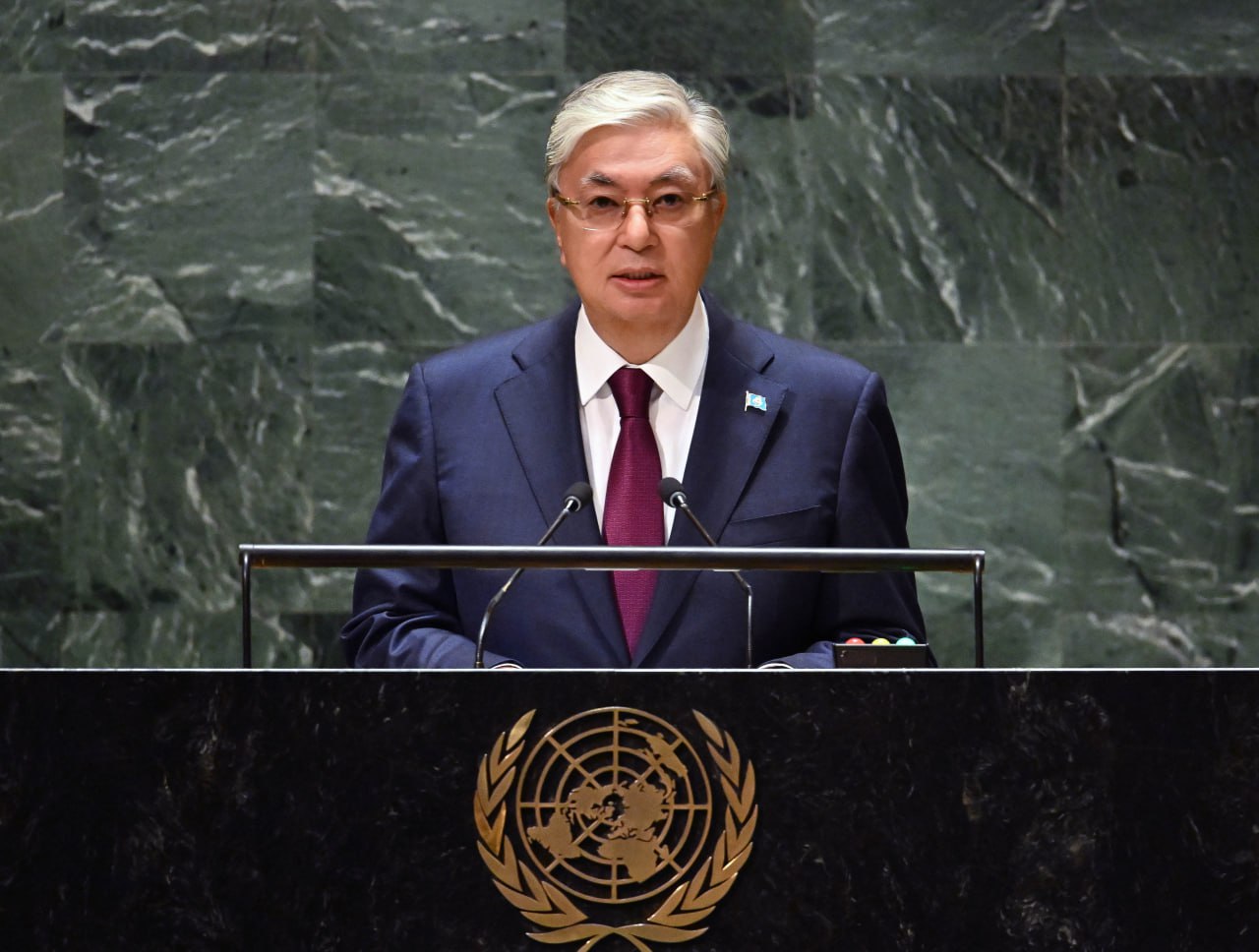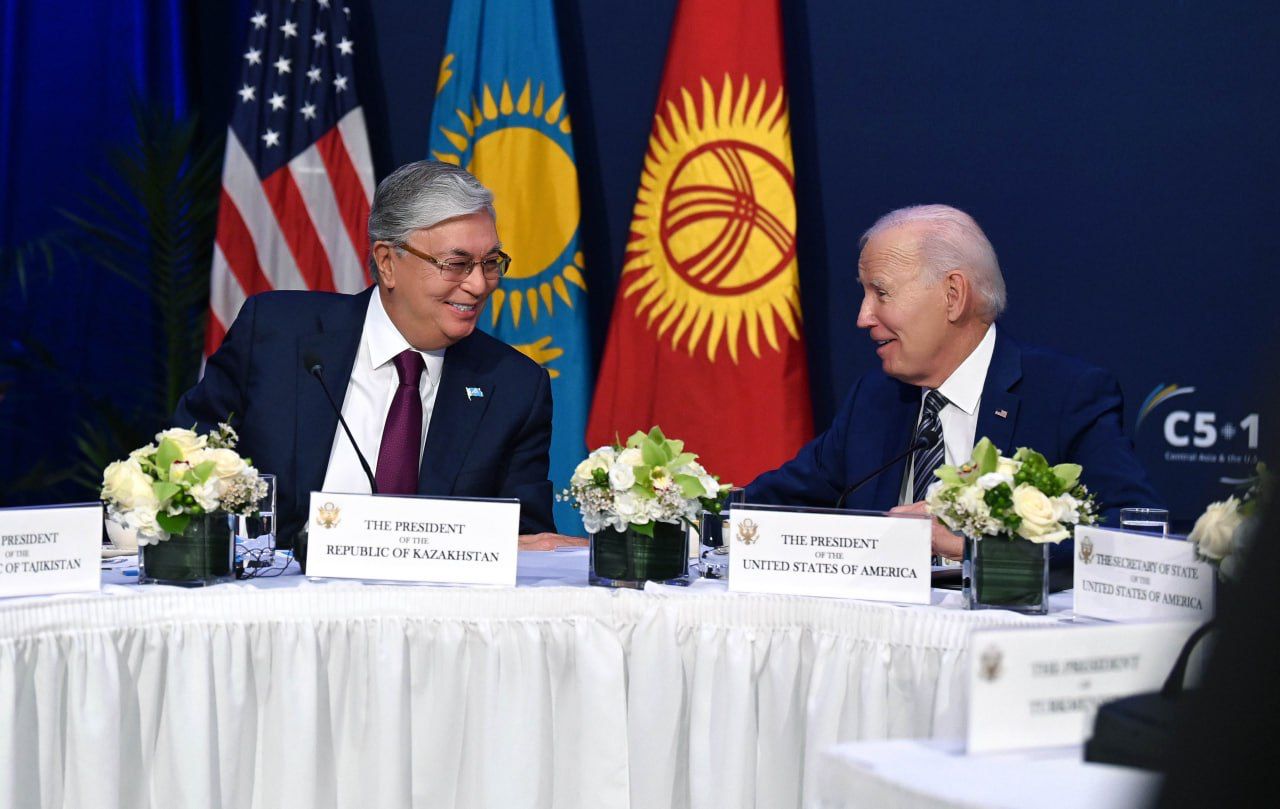ASTANA – This week, President Kassym-Jomart Tokayev concluded his visit to the United States, marking a significant milestone in the diplomatic relations between the two nations. During his visit, President Tokayev engaged in a series of high-profile meetings and events. These included discussions with American businesses, an address to the United Nations General Assembly, and participation in a C5+1 meeting with U.S. President Joe Biden. This visit has garnered significant attention in Kazakhstan and abroad.

President Tokayev delivered a powerful address on Sept. 19 at the General Debate of the 78th session of the UN General Assembly. Photo credit: Akorda.
Powerful address at the UN General Assembly
President Tokayev delivered a powerful address at the UN General Assembly on Sept. 19, calling for an urgent reform of the Security Council.
“In his speech, he noted the fundamental importance of dialogue and diplomacy in stabilizing the only existing system of global governance based on international institutions. Despite sporadic crises and systemic challenges, the UN and its agencies are the core of the institutional framework of the system of international relations. Today, the UN unites all internationally recognized states of the world, and its charter forms the entire current system of international law,” said Miras Zhienbayev, leading expert at the Department of European and American Studies of the Kazakhstan Institute of Strategic Studies.
Addressing the world leaders from the highest rostrum, Tokayev reiterated some of Kazakhstan’s important initiatives, including the Conference on Interaction and Confidence Building Measures in Asia (CICA), chairmanship at the Shanghai Cooperation Organization (SCO), the proposal to establish an International Agency for Biological Safety, and a UN Regional Center for SDGs for Central Asia and Afghanistan in Almaty.
C5+1 summit
The C5+1 format, comprising Kazakhstan, the Kyrgyz Republic, Tajikistan, Turkmenistan, and Uzbekistan, has gained prominence as a mechanism for dialogue and cooperation between Central Asian nations and the U.S. since its inception in 2015.

Tokayev and U.S. President Biden at the C5+1 meeting. Photo credit: Akorda.
Lidiya Parkhomchik, expert at the Institute of World Economy and Politics (IWEP), observes that the C5+1 platform has proven to be an “effective tool for discussing the prospects for cooperation between the five Central Asian countries and the U.S.”
“From its creation in 2015 until September 2023, all consultations took place at the ministerial level, as well as within the working groups on the economy, energy and environment and security. That is why the presidential summit on the sidelines of the UN General Assembly became an important milestone in the history of interaction between the parties,” she told The Astana Times.
She emphasized that the meeting did not seek to conclude with “breakthrough agreements,” but initiatives voiced are of paramount importance, with the stimulation of business ties being a top priority.
“Washington has voiced the idea of creating a more favorable business environment for trade and private sector investments. Specifically, it was suggested to establish a Private Sector Business Platform within the C5+1 framework,” she noted.
The second important direction is to intensify cooperation in the extractive sector. Currently, American companies have a significant presence in the oil and gas, as well as mining sectors of Central Asian countries, albeit less than Russian and Chinese companies.
Some of the notable American companies operating in Central Asia’s extractive sector include Chevron, ExxonMobil, General Electric, Honeywell, and Schlumberger, among others.
“The U.S. is proposing to place special emphasis on the production of critical minerals crucial for the green energy transition. As part of the C5+1 framework, it was suggested to initiate a dialogue on the development of strategically important minerals in Central Asia,” said Parkhomchik.
Central Asia and the U.S. are also committed to working together to explore the transport and logistics potential of the region. With connectivity already becoming a buzzword worldwide, it remains a priority for Central Asia and the U.S.
“Indeed, Kazakhstan is consistently working on advancing the Trans-Caspian International Transport Route [referring to the Middle Corridor], which has the potential to become an alternative transportation artery for trans-Eurasian shipments. In this context, Washington has reaffirmed its intention to increase investment in the development of the Middle Corridor as part of the Global Infrastructure and Investment Partnership initiative,” she explained.
Shared vision
In a statement released on the White House website, the leaders said they “share a vision for sustained cooperation to address the region’s complex challenges and emerging threats.”
“Collectively, we embrace the C5+1 goal of seeking regional solutions to global challenges. Together we affirm our commitment to activities in Central Asia that enhance security, improve economic resilience, support sustainable development, combat climate change, and promote peace,” reads the statement.
The joint commitment reflects the responsibility leaders are aware of, the responsibility that goes beyond their “own political careers, beyond even our time on Earth,” as President Tokayev wrote in his opinion piece published in The Hill.
The presidents committed to harnessing partnerships with international financial institutions to promote investment and create a business environment conducive to inclusive economic growth in the C5+1 countries.
This includes exploring new and innovative financing mechanisms at the World Bank and the Asian Development Bank to stimulate investments aimed at tackling global challenges such as climate change.
The U.S. Agency for International Development (USAID) C5+1 Connectivity Ministerial meeting is expected to convene in October to continue this dialogue on regional economic collaboration and discuss concrete actions for the C5+1 countries.
Back in September 2022, the U.S. committed $16.5 billion toward food and security in the region. It also initiated the Economic Resilience Initiative for Central Asia, a $25 million package to broaden regional trade networks, create export opportunities, boost private sector investment, and provide people with practical skills for the modern job market.
During his visit to Astana in February, U.S. Secretary of State Antony Blinken announced an additional $25 million for this initiative to build the regional economy.
Increased attention on Central Asia
Central Asia’s strategic importance, resource wealth, security challenges, and economic potential have placed it firmly on the radar of not only the U.S. The European Union has also shown heightened interest in the region in recent years.
Parkhomchik expects the role and significance of the Central Asian track in U.S. foreign policy will be on the rise.
“Throughout the year, Washington has been increasing its diplomatic activity in the region. The elevation of the status of meetings in the five-party format has become a natural outcome of this emerging trend,” she said.
Kazakhstan’s pivotal role
Experts also note the important role of Kazakhstan in the C5+1 dialogue, with some describing the nation as a “natural leader” in the region.
Parkhomchik does not rule out the possibility of Kazakhstan hosting the next summit.
Addressing his Central Asian counterparts at the summit, Biden said he “looks forward to seeing you all soon, possibly in one of your countries.”
For Kazakhstan, the dialogue between the countries of Central Asia and the U.S. is an opportunity to meet its national interests in relations with these countries at the regional level, said Alisher Tastenov, chief expert at the Kazakhstan Institute of Strategic Studies.
“Amid geopolitical turbulence, the C5+1 retains the role of one of the important tools in the realization of Kazakhstan’s multi-vector foreign policy,” he said.
Bringing American investments to Kazakhstan
Tokayev’s meetings with major American businesses are also seen as a significant move to attract American investments to the country. Kazakhstan, with its abundant natural resources and strategic geographic location, has long been an attractive destination for foreign investors.
Out of record $28 billion in gross foreign direct investment (FDI) inflow to Kazakhstan in 2022, the U.S. accounts for $5.1 billion, making it the second-largest investor in the country after the Netherlands, according to data from Kazakh Invest national company.
The total inflow of FDI from the U.S. to Kazakhstan exceeded $62 billion. Nearly 600 enterprises with the participation of American capital are present in Kazakhstan, and more U.S. companies are showing keen interest in the Kazakh market.
Parkhomchik mentioned data showing a 40% increase in trade turnover last year, reaching $3.1 billion. In the first seven months of 2023, bilateral trade amounted to $2.3 billion.
“At the same time, the U.S. is among the top five main import partners of Kazakhstan – $1.6 billion or 4.6% of the country’s total imports,” said the expert. “In April 2023, Astana expressed its intention to increase trade turnover by $800 million due to the growth of Kazakh exports across 90 commodity items.”


